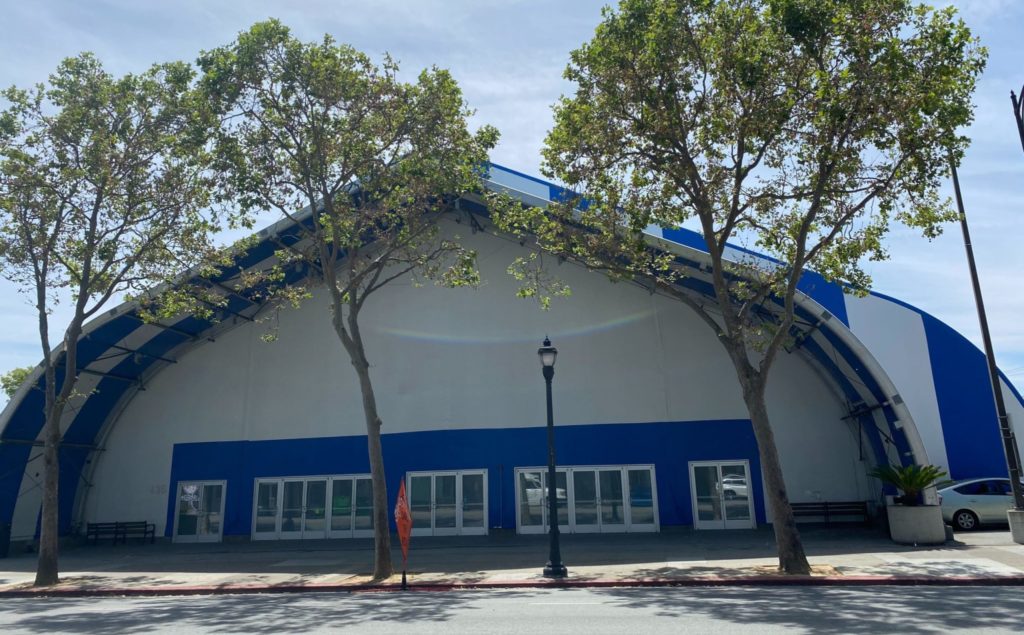Employees who work at Silicon Valley’s homeless shelters are putting themselves on the frontlines of the pandemic to protect the county’s most vulnerable residents, even as many live on the margins themselves.
Two homeless service providers in Santa Clara County told San José Spotlight that, between them, six of their hundreds of shelter workers have tested positive for the novel coronavirus. The county doesn’t have data to show how widespread the COVID-19 outbreak is at homeless shelters.
“These are incredibly high-risk environments,” said Ben King, an epidemiologist and clinical assistant professor at the University of Texas at Austin. In light of expected future pandemics and the inability to contain this virus, he said, “the very nature of shelter work has to change.”
Some local shelter workers are worried about being exposed to the virus and bringing it home to their families, said Shaunn Cartwright, an advocate for the county’s unhoused residents. While that’s led some employees to step back from their jobs, others continue to “take that risk every single day,” she said.
“They could say, ‘Peace out. I’m not paid enough for this. I’m going to stay home.’ But they come to work,” Cartwright said. “They’re forgotten heroes.”
South Bay shelter providers said they have implemented costly protocols to keep their spaces safe for everyone, including their workers. While HomeFirst and LifeMoves had a small number of people at facilities test positive, none are known to have had large outbreaks in their shelters like the ones occurring elsewhere.
They are also supporting their workers by providing masks, offering more paid leave and temporarily increasing pay.
“Our frontline shelter workers are first responders,” said Andrea Urton, CEO of HomeFirst. “They should be respected, cherished and honored as such.”
City and county officials say they’ve worked with shelters to ensure they have materials and support to keep workers and homeless residents safe. They’ve also pushed to get residents out of congregate shelters and into hotels and motels to prevent the spread of the deadly virus, where possible.
As of Wednesday evening, the county had reserved 681 rooms and placed homeless residents inside 296 rooms.
“We are providing around-the-clock support,” a spokesperson for the county wrote in an email.
The federal government has identified outbreaks at homeless shelters across the country. When those flare-ups occurred, workers were affected just like unhoused residents.
One study found 31 employees at five shelters in Boston, Seattle and San Francisco with outbreaks tested positive for the virus, accounting for about one-fifth of the employees tested there. When smaller outbreaks occurred at 14 other shelters, two employees total tested positive, the study showed.
Pandemic amplifies worker vulnerabilities
Shelter workers are a vulnerable population themselves. In San Jose, homeless shelter workers get paid an average of $18 per hour, according to ZipRecruiter.
In a city with some of the most expensive zip codes in the country, that kind of pay leaves some living paycheck to paycheck. There’s also no local union, a tool that can help workers advocate for themselves.
On top of that, the pandemic adds health risks.
Homeless shelter providers HomeFirst and LifeMoves each have had shelter workers test positive for the virus. HomeFirst officials said five workers out of more than 200 employees contracted the virus. At LifeMoves, one employee out of 300 tested positive.
The federal government recommends testing homeless residents and shelter staff where clusters have been detected and, if possible, before they occur.
King said steps like social distancing and handwashing in shelters are also crucial. Similar to the health care industry, he said shelter workers ideally should wear single-use N95 masks to protect from exposure to the virus.
Additionally, shelter providers have reduced, sometimes by half, how many people are allowed to stay in each shelter to make social distancing possible.

Jeff Scott, a spokesman for the San Jose Housing Department, said the city opened three new pop-up shelters and the county opened one too, to make up for the number of beds lost due to social distancing in permanent shelters.
The Valley Homeless Healthcare Program provides tests for all shelter workers when someone in the facility tests positive for the virus.
While all three providers mainly provide cloth masks for workers, Bruce Ives, CEO of LifeMoves, said his employees have access to N95 masks and face shields when workers may have been exposed to the virus.
Keeping workers ‘financially-whole’
Shelters rattled off a host of other steps they’ve taken to protect shelter workers, from purchasing ultraviolet sanitizing lights to screening people for symptoms before they enter shelters.
Shelter officials say they’ve also temporarily increased employees’ pay and some offered additional leave.
“The average working person is about $400 away from being homeless at any given time, and a lot of those people are our shelter workers,” said Urton. “We made a commitment to keep our employees financially-whole during this process.”
It’s likely that the pandemic will change how homeless shelters operate to protect workers and clients. Scott said some changes like social distancing at shelters will remain in place “for the foreseeable future.”
As shelters get used to this new normal, some providers worry about meeting an increased need for shelter services that were already scarce as a recession appears imminent.
A March memo from the county shows temporary housing options before the pandemic could shelter nearly 2,100 people, including emergency shelters, weather-dependent shelters, safe parking and interim housing programs. In 2019, Santa Clara County had 9,706 homeless residents.
“I’m wondering what services are going to stay, which encampments will keep porta potties and garbage pickup. Right there, you’re telling someone that they matter,” Urton said. “To take that away — crisis over, now we don’t care — that worries me.”
Contact Rachel Leven at [email protected] or follow @rachelpleven on Twitter.



Leave a Reply
You must be logged in to post a comment.